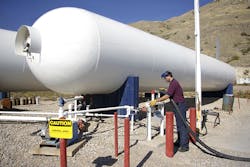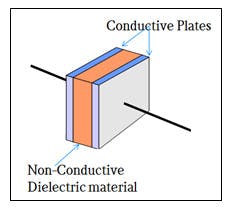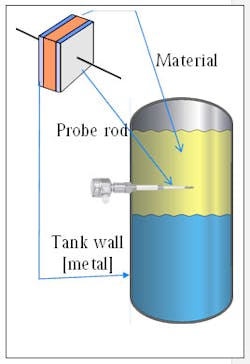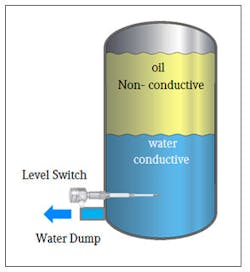Level interface sensing in oil fields and refineries
In a fracking operation at oil and gas wells, both water and oil come to the surface and must be separated. Hydrocarbons are filtered from the water fairly easily, but the remaining water — called "produced water" — is contaminated and must be treated before release into the environment.
Fracking is widely used in the oil and gas industry. As its use grows, treating produced water coming from wells is a major challenge, especially because cleaning produced water costs about 300 times that of cleaning municipal wastewater.
A similar problem exists at oil refineries, where incoming crude oil contains water that must be removed prior to refining. Upon arrival at refineries, crude may contain anywhere from 3 to 5 percent water.
Whether separation is done at the well site or refinery, measuring the level of the interface between oil and water in the separation vessel is critical. Correct measurement ensures the maximum amount of oil is drawn off for refining and a minimum of hydrocarbons are sent to the water treatment process.
Separation processes
Oil in production fields contains varying amounts of water depending on the oil reservoir, well maturity and extraction methods used. Some separation of water from oil is done in the field to reduce the amount of water transported to the refinery.
At a well site, especially one where fracking is done, separated water must be treated on site or at a nearby water treatment facility before returning to the environment.
Refineries take in crude oil from production fields based on basic sediment & water (BS&W) measurements. The higher the BS&W measurement, the more water is in the crude. Refineries use gravity separation, desalter vessels, skim tanks and other equipment to remove water and other impurities.
In all these processes, water separated from the oil is evacuated from the vessel bottom, while hydrocarbons typically are continuously removed by flowing over a baffle at one end of the separation vessel (Figure 1).
Water dumping
Removing water from the separation vessel is referred to as a "water dump." Because of the high cost of treating the water, it is critical to know when the interface between the water and oil reaches a low point to prevent dumping oil to the water treatment facility.
In some cases there are fines for dumping hydrocarbons to the water treatment plant; second, the whole idea is to maximize hydrocarbon throughput to refining, not dump it down the sewer.
A number of methods measure the interface between water and oil. These include everything from manual sampling to sophisticated continuous-level measurement using guided wave radar and gamma radiation transmitters.
But for water dump control, an on/off capacitance level switch inserted near the water outlet is almost always the preferred alternative, for reasons delineated below.
Inside capacitive switches
A capacitor is made up of two conductive plates separated by a non-conductive "dielectric" material, as shown in Figure 2.
Dielectric materials are categorized by their "Dielectric Constant" or "DK" which tracks the material’s ability to store a capacitive charge. The higher the dielectric number, the more capacitance stored.
Capacitance is equal to the DK (Dielectric Constant), times the Area of the conductive plates, divided by the Distance between the two plates, or:
C = (DK * A) / D
Capacitance sensors for level measurement use these basic capacitance concepts, with the vessel becoming one plate of the capacitor (Figure 3) in point-level applications. That is, the probe becomes one conductive plate, the vessel or a ground reference becomes the second conductive plate, and the material being measured is the dielectric material. In the case of conductive materials such as groundwater, the plates are essentially shorted out, providing a large change in capacitance.
A bridge circuit in the sensor’s electronic unit is balanced to null out the capacitance generated by an uncovered sensing element. As material covers the probe, an increase in capacitance is generated on the probe side of the bridge, which causes the bridge to become unbalanced. This change is converted to a switch command to allow a relay or other output to indicate the status of the switch, either covered or uncovered.
In the case of materials that leave a coating on the probe, active buildup compensation in the electronic unit provides a means to compensate for the coating and continue to provide reliable measurement.
Water dump applications
Using a capacitance switch to identify the interface between the oil and water is effective because of the dramatically different electrical properties of the two fluids. Groundwater is very conductive and acts to short the two plates of the capacitor, causing an almost infinite change in the measured capacitance. The oil phase is not conductive, and the low dielectric constant of oil (around 2DK) causes a small change in the measured capacitance. This results in a very clear electrical definition between the two phases.
In a water dump tank, the sensor is covered with a mixture of oil and water until the separation process proceeds, when oil moves to the top and relatively clean water moves to the bottom. The separated water still contains some oil, grease, iron, polymer additives, paraffin wax and other contaminants that will be removed in the ensuing water-treatment process. The sensor will probably never see pure water. However, even with the contaminants, the water phase will be conductive, making it electrically different than the oil phase.
The capacitance switch is mounted at a point where the low interface between the oil and the water needs to be detected. This could be a horizontal installation just above the water dump outlet line (Figure 4). The capacitance switch could also be mounted directly into the water outlet piping, but a horizontal installation at the control point is preferred.
The capacitance switch is set with a large preload on the bridge circuit to make it less sensitive. This allows the switch to detect the water because of the large change in capacitance due to water’s conductive electrical properties. The low dielectric constant and non-conductive properties of the oil phase will not generate a large enough change in capacitance to exceed the large preload on the bridge circuit.
The result is that the switch will change states as soon as the water drops below the tip of the probe. This is an extremely reliable indication of the water/oil interface that can be used to stop dumping.
Other point level methods
Several other methods are available to detect the water/oil interface, but all have significant disadvantages as compared to capacitive level sensors:
Manual sampling — The manual sampling method is archaic, but is still used in many facilities. A number of valves are spaced vertically on the side of the vessel. An operator opens the valve briefly and pulls a sample. By observing the sample visually, it can be determined which valve yields water and the next closest valve where oil is present, thereby identifying the interface as between the two valves.
Manual sampling has a number of flaws. First, it only gives an idea of where the interface is located — that is, somewhere between two valves. Since samples are taken manually, the identified interface location is only as accurate as the last sample. It also relies on a visual interpretation of what is water and what is oil. This interpretation is arbitrary and inconsistent with different operators. Last, it is an operator’s judgment to decide when to stop dumping, which adds to the human-error factor.
Sight Glass — A sight glass located in the water dump outlet line can be used to visually discern the change from the water phase to the oil phase. As in the manual sampling method, it relies on a visual interpretation of what is water and what is oil. Also, because the sight glass is in the outlet line, some oil will inadvertently be dumped. As this is a manual function, human error is introduced.
Conductivity Switch — Conductivity switches operate by passing an electrical current from one electrode to a second electrode through a conductive liquid. In an oil/water interface application, the current passes through when water is present. When the liquid changes to non-conductive oil, the current no longer passes between the electrodes and the switch indicates a change of state.
Conductivity switches provide reliable interface detection in many installations. However, if the electrodes become coated with a non-conductive material such as heavy crude oil or paraffin wax, the electrode will no longer pass current. This will indicate a false reading until the electrodes have been cleaned. For this reason, conductivity switches should only be used in separation processes where the phases are free of heavy material or contaminants.
Float Switch — Float switches can be used for measuring the interface between water and oil. The float is calibrated for the specific gravity of water, which is 1.0 or slightly higher. The oil has a lower specific gravity, generally between 0.7 and 0.9. As the water level drops the float arm moves down, providing an indication of the low water control point.
Floats can be problematic in water dumping applications for several reasons. The moving parts of the float switch are susceptible to wear and damage. The float can be compromised, causing it to sink. Heavy crude and wax can build up on the float and float arm, causing hang-up and failures. Finally, the specific gravities of both the groundwater and the oil are variable, requiring calibration "tweaks" on a regular basis.
Final words
When comparing point level instruments that can detect the water/oil interface, the capacitance sensor stands out as the best choice. Capacitance level switches are simple to calibrate and can be installed horizontally or vertically. There are no moving parts to wear out or hang up. Because capacitance has the advantage of active build-up compensation, materials that coat, such as heavy crude or paraffin, are not problems.
Capacitance level switches provide reliable water oil interface detection, and help to automate the water dump control process.
Endress+Hauser is a leading supplier of industrial measurement and automation equipment, with comprehensive process solutions for flow, level, pressure, analysis, temperature, recording and digital communications across a wide range of industries, optimizing processes for economic efficiency, safety and environmental protection.




